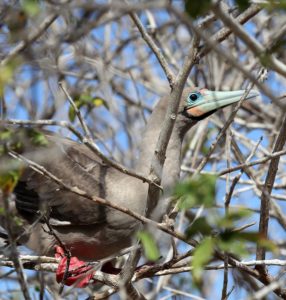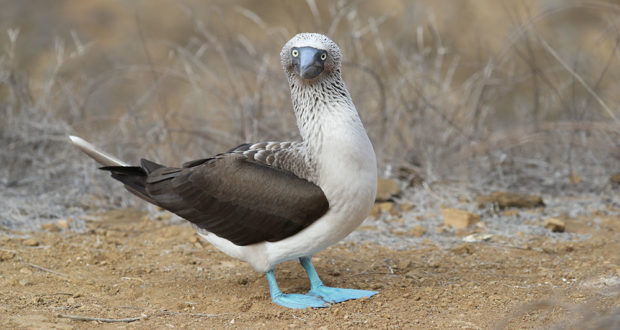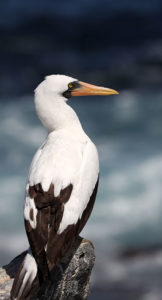Its stout slate blue beak is too big for the rest of its body. Two close, beady eyes stare out from either side of its beak, giving it both good depth perception and a look that says, “What?” Below, its ducky feet are dipped in bright turquoise paint. When courting, the male points its long bill skyward, doing a clumsy stomping dance to music only it can hear.
Darwin didn’t mention the Blue-footed Booby (Sula nebouxii) in his Galapagos journals, probably because he’d seen them before. They inhabit the Pacific Coast of Central and South America, from Baja California to Peru. The 20,000 breeding pairs in the Galapagos are an endemic subspecies (S. n. excisa) and account for about half the world population.
The blue feet come from cartenoids in the bird’s diet of fish. If you stop feeding them, their feet quickly fade to gray. The blue feet probably evolved through sexual selection. Males with especially blue feet have more robust immune systems and are generally healthier because they are eating well. And females’ feet turn a dark blue when they are ready to mate. Over time, birds with an eye for blue feet produced more surviving offspring.
Blue-footed Boobies nest in little more than a depression scratched in the dirt. On my visit to Punta Pitt, dozens were spread throughout the barren highlands, sometime right in the middle of the foot path. Most had either two eggs or one hatchling and one unhatched egg. Born scrawny and bare, the hatchlings quickly develop a fuzz that turns them into adorable puffs of white down. When my colleagues came a week later, the hatchlings from the previous week were noticeably larger and already standing up on their own. The young apparently hatch one a time, helping to spread out the work of parenting and perhaps allowing one to get a head start when food is scarce. The birds are monogamous, with the male’s degree of participation in raising the young growing with the size and brightness of the female’s eggs. They appear willing to invest more in offspring that are more likely to survive.
When foraging, Blue-footed Boobies dive from great heights to as deep as 80 feet under water in pursuit of schools of sardines, anchovies and other small fish. I watched three of the birds feeding in the surf at Puerto Chino. They made a wide circle in the air before plunging into the water at up to 60 mph with the negligible splash of an Olympic diver.

Red-footed Booby nodding in a Palo Santo tree just off the trail at Punta Pitt on San Cristobal Island
The first Red-footed Booby I saw was perched in a barren tree, where they usually nest. It periodically made a bowing motion with its head and neck. Most have a light brown body but a few are a stark white. Their beak is a powder blue with a darker patch around the eye and salmon accents above and below. Their mating call is a distinctive raspy quack that echoed against the rock walls of Punta Pitt as they flew by. They lay a solitary egg on their nest of sticks. They are more common but less widespread than the Blue-footed Boobies with a Galapagos population of about 140,000 pairs.
The Nazca Booby is the largest of the Galapagos boobies, with a wingspan of more than 60 inches. I watched a large colony of them on the sea cliffs of Espanola, where they were so thick that their droppings had whitewashed the rock face. Its feet are a nondescript gray, but its overall appearance is much more elegant than the other two. Young birds are brown but fade to white as they mature. It produces two eggs but only one of its offspring fledges. On a sunny morning the birds steadily flew back and forth between two colonies on adjacent cliffs, soaring above the surf with little effort. The Nazca is a separate species endemic to the Galapagos.

